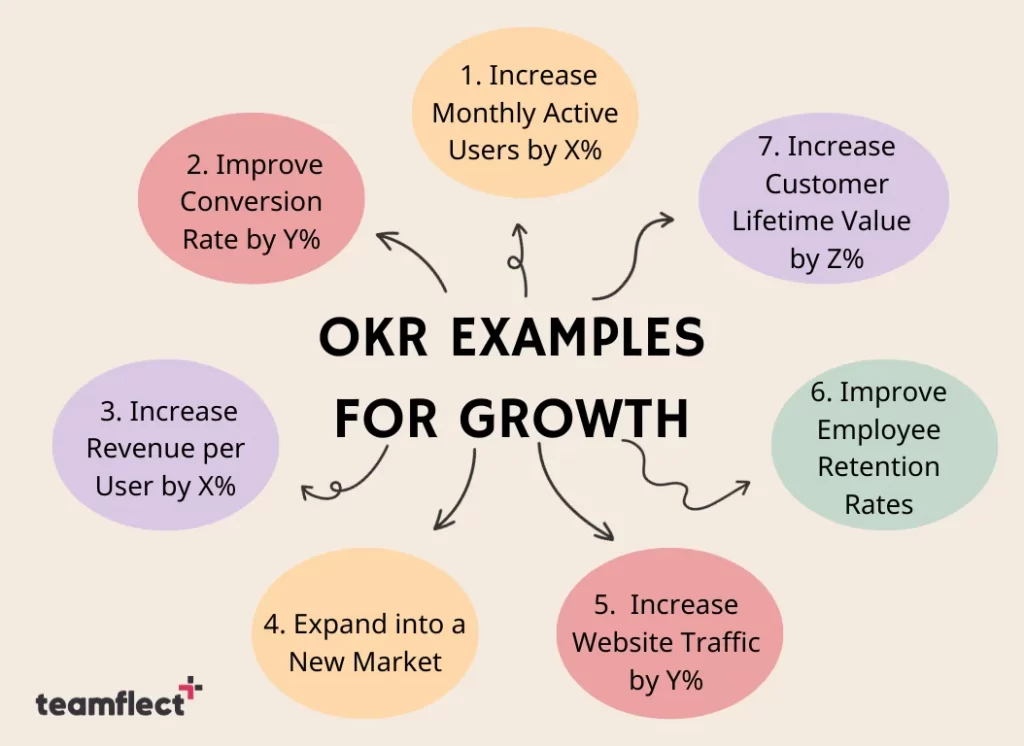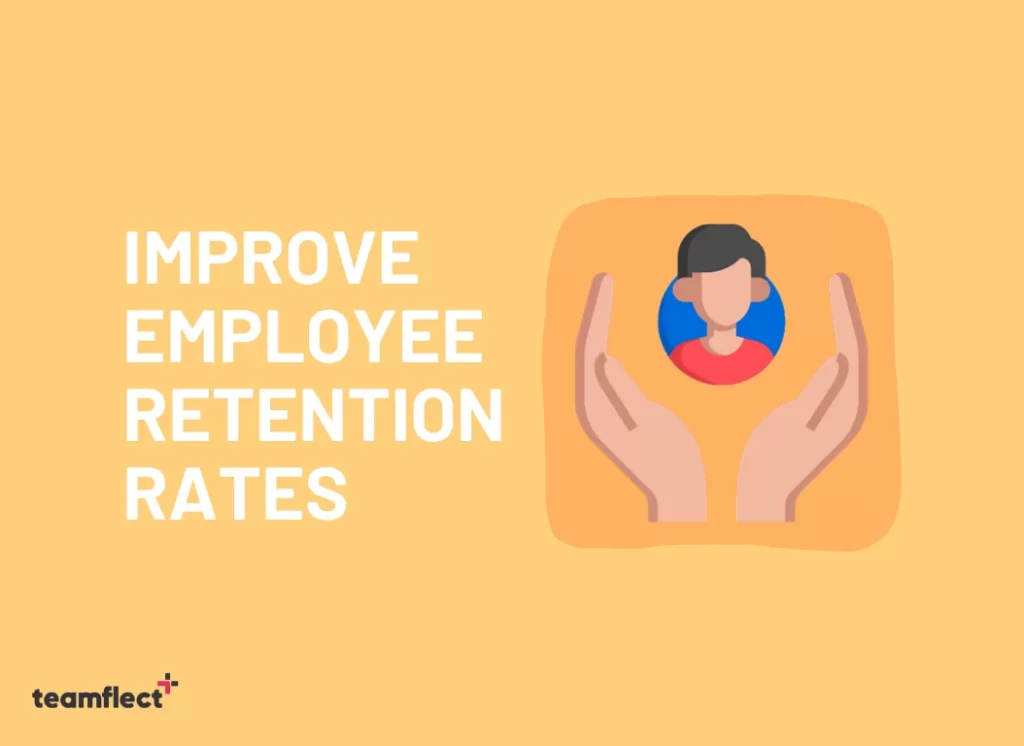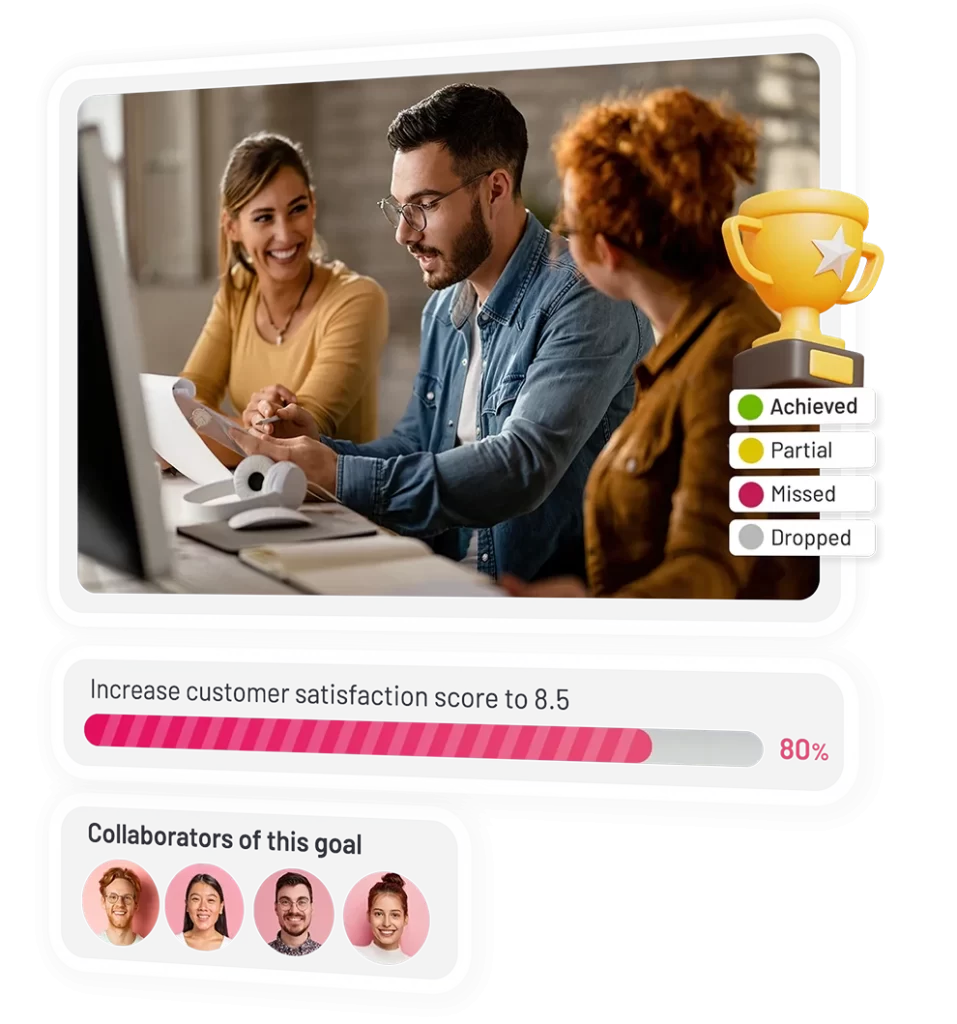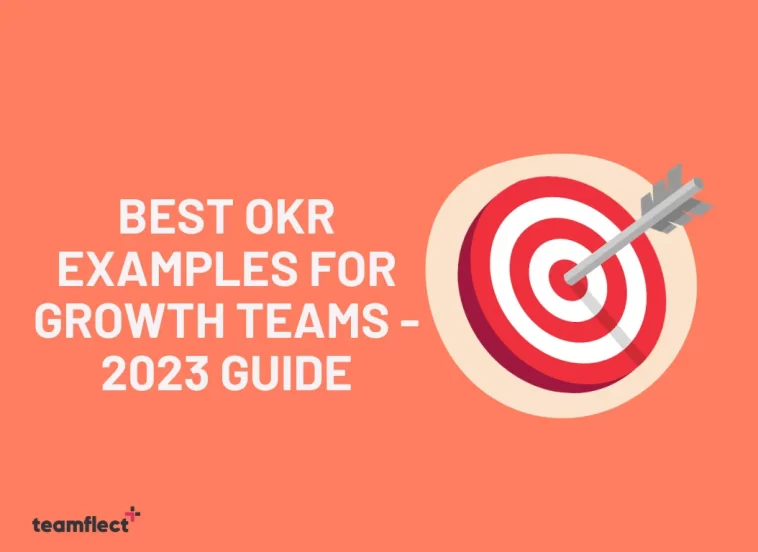Before we dive into OKR examples for growth, let’s quickly cover what OKRs actually are and why they’re so great. OKRs (Objectives and Key Results) are a goal-setting framework used by businesses to help teams focus on what’s most important.
They consist of an objective, which is a specific and ambitious goal, and one or more key results, which are measurable outcomes that will indicate progress towards that objective.
You may ask what are the benefits of using OKRs and why should you bother using them. Well, for starters, OKRs provide clarity and focus, helping teams prioritize their work and ensure everyone is aligned towards the same goals.
OKRs also encourage innovation and continuous improvement, as teams are encouraged to set ambitious goals and come up with creative solutions to achieve them. You’ll end up providing a way to measure progress and celebrate wins by using OKRs, which can be incredibly motivating for teams. OKR framework templates are mentioned in our blog before, and they help organizations to set clear goals for their growth.
So, we’ve already covered the benefits of OKRs, but why is it important to set growth-oriented OKRs specifically? As you may guess, growth is what keeps businesses thriving and evolving.
Setting growth-oriented OKRs means you’re essentially setting your sights on the future and taking steps to ensure your company is constantly improving and expanding.
Growth-oriented OKRs also help you focus on the most important areas of your business, whether that’s increasing your customer base, improving conversion rates, or boosting customer lifetime value. You can ensure that your team is aligned towards the same objectives and working towards a common vision with specific goals in these areas.
Overall, setting OKR examples for growth is crucial if you want to keep your business moving forward and staying ahead of the competition. So, let’s take a look at some examples of growth-oriented OKRs and OKRs best practices you can use for your own company!
Table of Contents
OKR Examples for Growth

OKR Example 1: Increase Monthly Active Users (MAUs) by X%
Alright, let’s get into some specific OKR examples for growth! First up, we have increasing monthly active users, or MAUs, by a certain percentage.
Using this or a similar OKR would be useful in your organization because it directly impacts on the growth of your customer base, which in turn can lead to increased revenue and market share.
You’ll need to track the number of unique users who engage with your product or service within a given month to measure MAUs, and then you can set a specific target for increasing this number, whether that’s by a percentage or a set number.
You can use HR analytics software to monitor your MAU numbers over time and adjust your tactics as needed to track your progress.
So, how can you actually achieve this growth OKR? Well, there are a variety of tactics you can use, such as optimizing your website or app for user engagement, creating targeted marketing campaigns to attract new users, or implementing referral programs to encourage your current users to invite their friends.
The key is to experiment with different strategies and see what works best for your specific business and target audience.
The key results for this OKR are:
- Achieve X% increase in the number of new user registrations on the platform within the quarter/year.
- Increase the retention rate of existing users by Y%, resulting in a X% increase in the number of active users each month.
- Implement and test three new features aimed at improving user engagement, and achieve a Z% increase in MAUs as a result.
OKR Example 2: Improve Conversion Rate by Y%
Let’s dive into our next professional development OKR example: improving conversion rate by a certain percentage, let’s call it Y%. You can use this OKR because it focuses on improving the efficiency of your sales funnel, which can lead to more revenue from your existing customer base.
Track the number of visitors to your website or app who complete a desired action, such as making a purchase or signing up for a newsletter in order to measure conversion rate. After this, set a specific target for increasing this number, whether that’s by a percentage or a set number.
Some tactics you can use to complete this growth OKR examples include improving your website or app design to make it more user-friendly and intuitive, creating targeted content that speaks directly to your audience’s pain points and needs, and using A/B testing to experiment with different calls to action and messaging.
Our example key results for this OKR are:
- Optimize the website’s landing page design and messaging to achieve a Z% increase in click-through rates (CTRs) within the quarter/year.
- Implement and test a new email marketing campaign aimed at converting more website visitors into paying customers, resulting in a Y% increase in the conversion rate.
- Conduct user research to identify potential pain points in the customer journey, and make UX improvements that result in a Y% increase in the conversion rate on the website.
OKR Example 3: Increase Revenue per User (RPU) by X%
When it comes to driving growth for your business, increasing revenue per user (RPU) is a key metric to consider. Essentially, this OKRfocuses on increasing the amount of money each customer spends with your business. Achieving this objective will help you improve your bottom line and position your business for sustained growth.
One effective way to increase RPU is by offering upsells, cross-sells, and other value-added services that encourage customers to spend more.
Upselling involves offering customers a higher-priced product or service that provides greater value or more features than their original purchase. Cross-selling involves offering customers complementary products or services that enhance their experience or meet other needs they may have.
In addition to upselling and cross-selling, you can also increase RPU by offering subscription-based services or tiered pricing plans.
Provide customers with a range of options to choose from to increase the likelihood that they’ll spend more with your business over time and achieve these growth OKR examples.
We recommend implementing these 3 key results for this growth OKRs:
- Introduce and test a new pricing strategy, resulting in a Z% increase in the average revenue per user within the quarter/year.
- Identify and implement three upsell opportunities for existing customers, resulting in a X% increase in the revenue generated per user.
- Conduct customer research to understand their needs and pain points, and create and market a new premium service that results in a Y% increase in the revenue per user.
OKR Example 4: Expand into a New Market

Expanding into a new market is a professional development OKR example that can have a significant impact on the success of your business. Essentially, this OKR focuses on growing your customer base by identifying and entering a new market that is currently untapped or under-served.
You can diversify your customer base, increase your revenue streams, and establish a competitive advantage in your industry by achieving this OKR.
One of the first steps to achieving this OKR is to conduct market research, which involves gathering data on the new market you want to enter, including demographics, buying behaviors, and consumer preferences.
Once you’ve identified your target audience, you can begin developing marketing strategies to reach them by creating targeted advertising campaigns, developing content marketing strategies, or leveraging social media to build brand awareness and drive traffic to your website.
Another key aspect of this OKR is building relationships with local businesses and stakeholders in the new market. Networking with industry leaders and building partnerships with local businesses helps you to establish a foothold in the new market and position your business for long-term success.
Stay customer-centric and continuously iterate your products and marketing strategies based on your customers’ feedback to establish a loyal customer base in the new market and achieve sustainable growth for your business.
Key results:
- Conduct market research to identify potential new markets and select the most promising one, resulting in a detailed market analysis report within the quarter/year.
- Develop a localized marketing strategy tailored to the new market, resulting in a X% increase in website traffic from the new market and a Y% increase in lead generation from that market.
- Build partnerships with local distributors, suppliers, or resellers in the new market, resulting in the establishment of X new partnerships within the quarter/year and an expected Z% increase in sales from those partnerships.
OKR Example 5: Increase Website Traffic by Y%
Driving more traffic to your website is a growth OKR example that can help you increase your online visibility, generate more leads, and ultimately boost your sales. In today’s digital age, having a strong online presence is crucial for businesses of all sizes, and achieving this objective can be key to your success.
One of the most effective ways to achieve this OKR is by investing in search engine optimization (SEO). SEO involves optimizing your website’s content and structure to rank higher in search engine results pages for relevant keywords and phrases, which can help you attract more organic traffic to your website and improve your overall visibility online.
Another strategy to achieve this OKR is through content marketing. Creating high-quality, relevant, and engaging content on your website and other platforms such as social media will result in attracting more visitors to your website and establishing yourself as an authority in your industry.
You can also attract backlinks from other websites, which improves your website’s authority and rankings in search engine results pages.
To achieve this objective, it’s important to have a clear understanding of your target audience and their needs. Create content that speaks to your target audience’s pain points and interests to attract more visitors to your website and keep them engaged with your brand.
It’s also important to monitor your website traffic and analyze the results of your marketing efforts to make data-driven decisions on how to improve your strategies.
Key results for this growth OKR:
- Implement a content marketing strategy that includes creating and promoting X new pieces of high-quality, SEO-optimized content each month, resulting in a Y% increase in organic traffic to the website within the quarter/year.
- Launch a paid advertising campaign on targeted platforms, resulting in a Z% increase in website traffic from those campaigns within the quarter/year.
- Implement a social media marketing strategy that includes creating and posting engaging content on X social media platforms, resulting in a Y% increase in referral traffic from those platforms within the quarter/year.
OKR Example 6: Improve Employee Retention Rates

One of the critical factors in achieving business growth is retaining top talent within the organization. It can be challenging to find and hire high-performing employees, so it’s important to ensure that they remain satisfied and motivated to continue contributing to the company’s success.
Employee retention is also essential because it can be costly to replace employees who leave, from recruiting and training to the time it takes for the new hire to become fully productive. If you’re wondering about employee retention best practices, check out our blog post first!
To achieve this OKR, you can start by assessing your current employee retention rates and identifying any areas for improvement. You can then develop strategies and programs that address those issues, such as offering competitive salaries, comprehensive benefits, flexible work arrangements, and opportunities for advancement within the company.
Creating a positive work culture is also essential in retaining employees. Employees who feel valued and supported in their jobs are more likely to stay with their employer.
Encouraging open communication, providing feedback and recognition, and fostering a sense of community can help create a positive work environment. You can use performance review software to track and hold your best employees with you throughout your organizational growth!
Providing opportunities for career growth and development is another critical factor in employee retention. Employees who see a clear path for advancement and development within the company are more likely to stay and contribute to its growth.
You can offer training and development programs, mentorship opportunities, and performance-based promotions to help your employees achieve their professional goals while supporting the company’s growth.
Example key results are:
- Conduct a company-wide survey to identify factors that affect employee satisfaction and implement solutions to address the identified issues, resulting in a X% decrease in employee turnover rate within the quarter/year.
- Implement a career development program that includes training opportunities and career advancement plans for employees, resulting in a Y% increase in employee retention rates within the quarter/year.
- Create and implement an employee recognition and rewards program that encourages and recognizes high-performing employees, resulting in a Z% increase in employee engagement and retention rates within the quarter/year.
OKR Example 7: Increase Customer Lifetime Value (CLTV) by Z%
These examples of OKRs include increasing customer lifetime value, or CLTV, by a certain percentage Z. This specific growth OKR focuses on getting your existing customers to spend more money with your business over time, which leads to more revenue and increased loyalty.
We recommend calculating the total amount of money a customer spends with your business over their lifetime as a customer to measure CLTV.
Then, we have some tactics you can use to achieve this OKR include creating targeted upsell and cross-sell campaigns that recommend additional products or services to existing customers, offering loyalty rewards and incentives that encourage customers to make repeat purchases, and improving your customer service and support to ensure a positive experience for every customer.
Remember, the goal is to provide value to your customers, so they continue to choose your business over your competitors.
Our last recommendation of key results for this growth OKR is:
- Increase the frequency of customer purchases by implementing a loyalty program that rewards customers for repeat purchases, resulting in a X% increase in CLTV within the quarter/year.
- Improve customer retention rates by identifying and addressing customer pain points and complaints, resulting in a Y% increase in CLTV within the quarter/year.
- Increase the average order value by offering product bundles, upselling techniques or cross-selling complementary products, resulting in a Z% increase in CLTV within the quarter/year.
OKR Example 8: Customer Success
Your customer success OKR examples should aim to satisfy your customers with your products or services while ensuring their needs are met. With customer success OKRs you are trying to create long-term customer loyalty. Customer Success key results often include metrics such as retention rates, customer satisfaction rates, and support responsiveness.
Objective: Improve customer satisfaction and loyalty with your customer success teams by making sure that they are happy and loyal.
Key Result Examples:
- Increase the average customer satisfaction score to above 90% by the end of the year.
- Reduce customer complaints by 20% and decrease the customer support response time to less than 24 hours.
- Enhance customer education programs to increase the annual contract renewal rate of existing customers by 50%.
OKR Example 9: Marketing
The aim of marketing OKR examples is to increase brand awareness, attract customers, and boost conversion rates. To achieve your marketing objectives, you need to align them with the company’s growth and revenue goals. Your key results should include metrics that are linked to website traffic, social media engagement, conversion rates, and lead generation.
Objective: Driving interest in your products or services and engaging potential customers, as a result increasing brand awareness.
Here are some common elements of Marketing OKRs:
Key Result Examples:
- Increase monthly website visitors by 30% by the end of the year.
- Boost social media engagement by 50% annually and grow the follower count by 20%.
- Improve conversion rates by 25% by refining content marketing strategies.
OKR Example 10: Software
The aim of the software OKR examples is to improve the efficiency and quality of the software development process. To achieve software development OKRs you need to accelerate product development processes, reduce bugs, and enhance software quality. Your key results in this category can include metrics associated with release cycles and bug tracking.
Objective: To speed up product development processes and increase software quality.
Key Result Examples:
- Deliver software updates 20% faster than the previous year, with an average release cycle of 2 weeks.
- Decrease the number of critical software bugs by 15% through improved quality assurance processes.
- Achieve a Net Promoter Score (NPS) of 70 or higher for the software product by the end of the quarter.
Tips for Setting Effective Growth OKRs
Use OKR software
We recommend using OKR software to streamline the entire OKR process from start to finish. Many software options offer a variety of helpful features, such as goal-setting templates, progress visualization tools, and automated updates.
These features can make it easier to create and manage your OKRs, keep track of progress, and adjust your strategy as needed. We’ve collected top 10 OKR software for you to find the best one, but we have a specific recommendation for those who use Microsoft Teams for collaboration.
Teamflect is the only cross-platform performance management solution that works natively inside Microsoft Teams. It eliminates the need to toggle between different applications and speeds up workflows by allowing users to access all of their tools from within a single interface with its seamless Microsoft Teams integration.
You can create goals and OKRs without ever having to leave Microsoft Teams chat, let alone the Teams application. Teamflect supports its OKR module with incredible task management, customizable employee recognitions and streamlined performance reviews—all inside Microsoft Teams.

Teamflect also lets users create detailed, highly customizable meeting agendas that include goals and OKRs, task setting, and 360-degree feedback.
Key Features:
- The best performance management tool for Microsoft Teams
- Automated goal check-ins
- Customizable employee feedback templates
- An extensive performance review template gallery
- Keeps the performance review cycles within a single app
- Customizable employee recognition
- User-friendly design
Make them specific and measurable
It’s important to make sure your OKRs are specific and measurable, which means setting concrete targets that you can track and analyze over time. For example, instead of setting a vague goal like “increase revenue,” you could set a specific target like “increase revenue by 20% in the next quarter.” This gives you a clear benchmark to work towards and allows you to measure your progress as you go.
Ensure they align with company goals and vision
Another important tip for setting effective growth-oriented OKRs is to ensure they align with your company’s overall goals and vision. Your OKRs should be designed to support your company’s mission and help you achieve your long-term objectives.
This means taking the time to understand your company’s strategic priorities and identifying areas where you can contribute to its success.
When it comes to setting effective growth OKR examples, there are a lot of moving parts to keep track of. You need to identify the right metrics to measure, create a plan of action to achieve your goals, track progress over time, and collaborate with team members to ensure everyone is on the same page. All of these steps can be time-consuming and complex, which is where OKR software can come in handy.
For example, if your company’s goal is to expand into new markets, you could set a growth-oriented OKR around increasing your customer base in a specific geographic region.
This helps to align your efforts with the broader goals of the company and ensures that you’re working towards a common objective. Performance management is the critical part of any organization to achieve their OKRs, and you can use performance management software to increase efficiency.
Consider the timeframe for achieving the OKR
Last but not least, when setting growth-oriented OKRs, it’s important to consider the timeframe for achieving them. While it’s important to set ambitious targets, it’s also important to make sure they are realistic and achievable within a specific timeframe.
For example, if you set a goal of increasing your customer base by 50% in a single month, that may not be feasible depending on your current market position and resources. Instead, you could set a more achievable target of increasing your customer base by 20% over the next quarter.
Mistakes to avoid while setting company OKRs
We have provided the best and the most useful company OKR examples and now it’s time to discuss the detrimental mistakes to avoid while setting your company OKRs!
1. Lack of alignment and clarity
Vague or unclear objectives will fail so it’s crucial to avoid them.
When setting company objectives it’s important to make sure that they are clear. In other words, they should be specific, measurable, achievable, relevant, and time-bound (SMART). Moreover, there should be alignment from the top-level company objectives down to individual or team objectives.
2. Setting Too Many Objectives
You may want to tackle too many objectives at one go but it will lead to a lack of focus and your efforts will not yield positive results. To avoid this problem you should limit the number of objectives and remain focused on the most critical ones.
3. Neglecting Key Results
When you solely focus on your objectives and neglect defining measurable key results monitoring your progress will be challenging. To overcome this problem you can pair each objective with a measurable key result that will serve as milestones while tracking progress.
4. Ignoring Regular Check-Ins
If you don’t want to have outdated objectives you should review them regularly. You need to schedule check-in meetings regularly to have a better understanding of your progress and make adjustments when needed while making sure that your objectives are aligned with changing company priorities.
5. Highlighting Individual Performance
When you highlight individual performance instead of focusing on the collaborative output, you can discourage other team members and collaboration. So, you need to focus on your team’s efforts and progress while measuring your OKRs instead.
6. Lack of Employee Involvement
If you want to create a sense of ownership in your employees you should involve them in the OKR setting process which will not only create ownership but also commitment. To achieve this you can make sure that they understand how their work contributes to more general company objectives.
7. Not Celebrating Success
If you neglect recognizing your employees they will become demotivated. For that reason, you should celebrate their accomplishments with genuine and specific praise.
On top of that, making sure that your appreciation is genuine and specific is the key to recognition that actually works in motivating your employees.
8. Neglecting OKRs after setting them up
OKRs shouldn’t be viewed as an annual or quarterly practice and they should be incorporated into your everyday operations. Why? Because OKRs require constant monitoring to make sure that everyone is on the same page and there is continuous progress.
Conclusion
And that’s a wrap on our blog post on OKR examples for growth! We hope you found these examples and tips helpful in setting growth OKRs examples for your business.
To recap, setting growth-oriented OKRs can help you achieve long-term success by focusing your efforts on concrete and measurable targets.
By making them specific, aligning them with your company’s goals and vision, considering the timeframe for achieving them, and involving relevant stakeholders in the process, you can set yourself up for success and help your business achieve sustained growth.
We encourage you to use the examples and tips provided in this blog post to set effective OKRs for growth in your own business.
Remember, the key to success is to make your OKRs specific, measurable, and aligned with your company’s goals and vision. By doing so, you can stay focused, motivated, and on track towards achieving sustained growth and success.
So, take the time to set some growth-oriented OKRs, involve your team members, and track your progress along the way. With a little effort and a clear plan in place, you can achieve your long-term growth goals and take your business to the next level. Good luck!
Frequently Asked Questions
What are the objectives of a growth team?
The primary objective of a growth team is to drive sustainable growth for a company which involves identifying and executing on opportunities to increase the company’s user base, revenue, and other key metrics. Some specific objectives that a growth team may focus on include:
Acquisition: Attracting new customers or users to the company’s products or services through various marketing channels.
Activation: Encouraging new users to engage with the company’s products or services, and become active and loyal customers.
Retention: Ensuring that customers or users remain engaged with the company’s products or services over time, and continue to use them on an ongoing basis.
Monetization: Maximizing the revenue generated by the company’s products or services, through strategies such as pricing optimization, upselling, and cross-selling.
Referral: Encouraging existing customers or users to refer their friends and colleagues to the company’s products or services, thereby increasing the user base and driving growth.
What are OKR growth?
OKR growth refers to the use of OKR framework specifically for driving growth within a company which involves setting objectives that are focused on specific growth-related outcomes, such as increasing user acquisition, improving retention rates, or boosting revenue.
These objectives are then broken down into specific key results that are measurable and quantifiable, allowing teams and individuals to track their progress and adjust their strategies as needed.
For example, an OKR growth objective might be to increase the number of new users by 50% over the next quarter. The key results that support this objective might include increasing the company’s marketing budget, launching a new referral program, and improving the onboarding process for new users.





